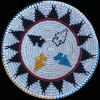
The number four is sacred to many Native Americans. There are four sacred directions, four sacred mountains, four sacred plants, and four times of day. It is believed that attempts to create new things are usually unsuccessful the first three times but are successful the fourth time. The Navajo believe that the four directions are alive and places where sacred things happen. Each direction has its own star or constellation, a color, and various associations.
East Direction is associated with the Great Divine or Big Star, positive thinking, and the development of concentration and the senses. South Direction is associated with the Pleiades or the Flint Brothers, planning, and with organization, communication, comprehension, and the planting of seeds. West Direction is associated with Cluster of Stars, Many Stars, and the Milky Way, life, and the clan system, kinship, social development, and life cycles. North Direction is associated with the Horned Star, spirituality, hope, strength, the natural order, sacred songs, prayers, ceremonies, and protection.










